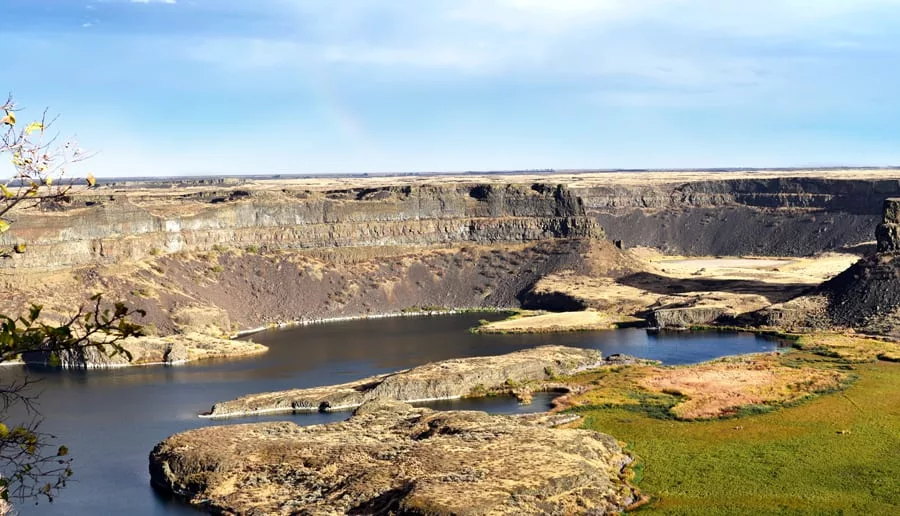
Home » Visit a unique geological formation in the heart of the Mid-Columbia
Visit a unique geological formation in the heart of the Mid-Columbia

December 21, 2015
[blockquote quote="The visitor center is here to tell the story of the catastrophic Ice Age floods that occurred in Northeast Central Washington." source="David E. McWalter, an Interpretive Specialist at the Dry Falls Visitor Center" align="right" max_width="300px"]
To get a rare glimpse into the Mid-Columbia’s unique geological history look no further than the Dry Falls — 3.5 miles of stark precipice 400 feet deep. Located in the heart of the channeled scablands in Central Washington about an hour north of Moses Lake, Dry Falls is exactly what its name suggests — a historic remnant of what was once the greatest known waterfall to have existed on earth. Niagara Falls, in comparison. is only 167 feet deep and one mile wide. This geological phenomenon may be a quiet and peaceful retreat now, but mighty and turbulent forces of nature shaped the land. Dry Falls combines a unique mix of educational and recreational opportunities. The falls are one of the main attractions at Sun Lakes-Dry Falls State Park, a 4,027-acre state park with 15 miles of hiking trails and 73,640 feet of freshwater shoreline. It’s the perfect for place for hiking, boating, fishing, wildlife viewing and bird watching.
The hiking trails offer views of rocky formations, desert plants and wildlife. Visitors can spend the day hiking, fishing and exploring, or swimming in the summer months, and then drive up to the Dry Falls Visitor Center. Throughout the park, different trails and roads offer unique views of geological features and are a great opportunity to get closer to desert plants and wildlife.
The visitor center houses an impressive interpretive exhibit telling the story of the area’s natural and geological history — from lava flows to the Ice Age floods and its Native American legacy to the modern discovery of how Dry Falls was created.
“The visitor center is here to tell the story of the catastrophic Ice Age floods that occurred in Northeast Central Washington,” said David E. McWalter, an Interpretive Specialist at the Dry Falls Visitor Center. “We’re right smack dab in the middle between Glacial Lake Missoula in Montana, the Columbia River Grand Coulee flowing south to the Tri-Cities. We’re on the scenic byway through the Coulee Corridor.” McWalter said the visitor’s center has information about nearby attractions and offers educational opportunities for local schools, which bring students there to learn about geology.
The scenic drop and potholes that cover the area produce a rugged, dramatic natural monument. Fire, ice and floods all played a role in creating the Mid-Columbia and especially Dry Falls. Beginning 100,000 years ago — during the Ice Age — a great glacial dam created Glacial Lake Missoula across 3,000 square miles of northwestern Montana. The lake grew in size and volume and eventually broke through and completely crushed the ice dam, unleashing catastrophic floods that ripped across the Idaho panhandle into Eastern Washington, and eventually emptying into the Pacific Ocean. The turbulence of the floodwaters eroded the surface soils and basalt underneath, leaving behind two major waterfalls. The larger one was the upper Coulee, where the river rushed through an 800-foot cliff. The other major waterfall — Dry Falls — started near Soap Lake, where basalt layers retreated before the erosive power of the floods.
These floods are thought to have advanced and covered the area as many as 85 times over the course of 16,000 years and are responsible for the rocky canyon-like geology found in the southern and central parts of Eastern Washington — known as the channeled scablands. But the Ice Age Flood isn’t the only natural phenomenon on display. Dry Falls is layered in natural history and is a geologist’s paradise. Before the floods a massive lava flow, one of the largest ever-recorded in history, blanketed the area and destroyed everything in its path. “As the water was flowing out of the Glacial Lake Missoula, it literally washed away and eroded all the topsoil, so all of this is bedrock, when you say scablands it means water that had been flushed across the land,” said McWalter. Dry Falls is a little over two-hour drive north from the Tri-Cities.
For more information on Dry Falls and Dry Falls-Sun Lakes National Park, go to parks.state.wa.us/298/Sun-Lakes-Dry-Falls.
Local News
KEYWORDS november 2015





